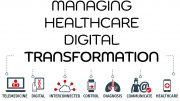MedEvolve is a leading provider of revenue cycle management (RCM) solutions that provide effective intelligence, automation and accountability for healthcare organizations in the United States. We spoke to MedEvolve’s Executive Vice President Matt Seefeld to find out how an AI-driven workforce and analytics can change staffing and performance dynamics within healthcare revenue cycles.
Given that labor shortfalls are here to stay for the foreseeable future, how can healthcare organizations overcome the impact to revenue cycle processes?
Going forward successful healthcare organizations must learn how to make the most of existing staff resources and identify strategies for increasing the effectiveness and capacity of employees. The ability to attract and retain top talent will also hinge on an organization’s willingness to acknowledge and embrace changing workforce dynamics.
Now more than ever, employees want flexible working conditions. The option for remote work has practically become an expectation with the increased emphasis on work-life balance. Most positions within revenue cycle departments can be structured for remote work, or even outsourced, but the key is to have the technology to monitor and measure staff performance and every touchpoint through the entire process.
What are the biggest challenges organizations face as they work to build strong revenue cycle teams and improve the outlook on tight operational margins?
Financial executives should prioritize reducing their cost to collect. Declining reimbursements, growing patient financial responsibility and staff shortages are wreaking havoc on their operational margin. One of the key metrics that many leaders are not focused on, but should be, is “zero-touch rate.” This is not “clean claim rate,” rather, “zero-touch” represents the percentage of claims that are processed and paid without ANY human intervention post coding.
This may sound harsh, but the best way to reduce cost is to reduce the amount of work (and people) required to do the work. Unfortunately, most healthcare executives lack visibility into the amount of work that’s required to resolve a claim or collect a payment, and that blind spot is costing them.
Traditional EHRs and practice managements systems simply do not have the capabilities to provide detail into all staff activity and their performance. Without this visibility, it’s virtually impossible to identify key areas for performance improvement as well as top performers. Healthcare executives need to be able to answer questions such as: “How many touches and staff does it take to resolve a claim?” and “How often are claims resolved without any human intervention?”
You’ve said Effective Intelligence solutions provide real-time insight into employee performance. What is effective intelligence, and how does it inform finance leaders’ approach to RCM and staffing challenges?
Simply put, Effective Intelligence solutions help the revenue cycle team become more “effective,” ultimately creating greater capacity to achieve ROI. The best solutions holistically address the full lifecycle of the revenue cycle, capturing data at every step and providing daily workflow guidance from front-end registration to back-end collections.
On the front-end, Effective Intelligence automates and centralizes pre-registration patient financial clearance functions, ensuring the process of getting claims paid on the back end starts off on the right foot. Financial clearance automation ensures patients are financially cleared ahead of their appointment by equipping staff with work drivers to check insurance eligibility, pre-authorization, coordination of benefits and collect co-pays or older balances up front.
On the back end, RCM workflow automation provides the guidance needed to ensure revenue cycle staff are not only productive, but also effective, in their work. These tools highlight tasks that have potential to produce the most ROI, rather than having staff waste time on activities that won’t produce an outcome or claims that do not need attention.
Effective Intelligence solutions also provide real-time insight into employee performance, allowing revenue cycle leaders to creatively implement incentive programs to motivate staff.
Atlas Healthcare Partners, one of the nation’s fastest-growing ambulatory surgery center (ASC) management companies, deployed Effective Intelligence infrastructures on the front end and back end across its 30 ASCs and achieved notable results. In less than a year, the organization realized a 97.5% net collection rate (NCR) on closed claims, a 97.5% pre-service patient collection rate, 31% decrease in labor dependence, and 48% reduction in denials across their four main payers. The organization also significantly improved its zero-touch rate and decreased refiles and tasks.
Worker productivity is a big topic in the current labor market. If staff gave just 10% more every day, how would that impact operational margin?
This is a question that all organizations should be asking themselves. Rather than throwing more bodies at the problem, how can leaders create more capacity within their existing teams?
The key to encouraging staff to give a little extra effort is to provide incentives. Data shows that incentivizing staff by providing rewards increases worker’s effectiveness and improves staff performance. Keep in mind incentives do not need to be financial; we’ve seen clients get creative with gift cards, time off, company swag, pizza parties and more. Adding some components of gamification such as points or a scoring system, leaderboards, badges, etc. can transform often mundane revenue cycle tasks into a motivating, game-like experience.
For example, Falck US, part of the global Falck organization, a leading international provider of emergency response and healthcare services, implemented of an incentive-based revenue cycle, and the organization banked an extra $21 million over their annual revenue goal.
In another example, Strategic Practice Solutions, a medical billing and practice management consulting firm, leveraged productivity and effectiveness data available for each employee to implement performance-based reward programs. On one occasion, the organization held a day-long contest to see which employee could achieve the highest number of “quality” touches that contributed to the bottom line. The prize was a simple gift card. As a result, the teams broke the threshold of what they thought they could achieve and had their highest collection month on record.
However, managers must have access to the right data to understand staff performance, including productivity and effectiveness, and establish measurable goals for each team member and for the team as a whole to successfully implement an incentive program.
How important is it to include processes like incentivizing staff and gamification and are there other ways healthcare organizations can create capacity in the workforce?
Incentive-based techniques are a proven method for motivating staff. When using Effective Intelligence technology, finance leaders have visibility into daily work effort of all staff and can use the data to create solutions to gain the greatest value of labor. We have seen organizations achieve significant gains through these techniques.
Another way to create capacity is to automate manual tasks so the work staff is doing is meaningful and not repetitive or redundant. This not only helps to streamline and expedite processes, but also improves staff morale because they feel that their work is important. Revenue cycle will always require human beings, but we need to make sure we have the right humans in the right positions doing the right work to be successful.





